| Article ID | Journal | Published Year | Pages | File Type |
|---|---|---|---|---|
| 1726484 | Ocean Engineering | 2011 | 9 Pages |
Rigid-body slamming has become increasingly important as ships travel at higher speeds experiencing larger loads during hull impacts against surface water which can result in structural damage and crew injury. It is necessary to characterise the hydrodynamic loading during water impacts.We present a series of experiments conducted in order to study slamming force events seen by flat plates during free surface impacts. The experiments focus on the characterisation of the loads experienced by flat plates during the first phase of the slamming event, the water entry. They have been conducted in an especially designed test apparatus, the Slingshot Impact Testing System (SITS), which allows us launching objects against the free surface of an open channel, with the possibility of setting up different speeds and deadrise angles. We can study slamming with trapped air between the plate and the water free surface, at high impact speeds and small deadrise angles, allowing us to quantify the resulting cushioning effect. High velocity impacts up to 5 m/s were conducted at angles between 0.3° and 25°. It was found that the trapped air phenomenon significantly cushions flat plate impacts with angles less than 5° and impacts with larger angles adhere to Von Kármán's equations.
► An experimental facility was designed for the study of water slamming loads at more than 5 m/s. ► New impact force data for flat plates slamming from low to high deadrise angles. ► Validation against data from previous slamming experiments. ► Data suggests a clear relationship between slamming coefficient and duration of impact. ► Visualisation of the slamming events including the trapped air phenomena is presented.
